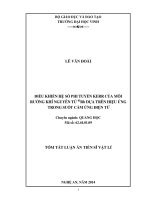Section 1 4 TRƯỜNG ĐIỆN TỪ
Bạn đang xem bản rút gọn của tài liệu. Xem và tải ngay bản đầy đủ của tài liệu tại đây (101.98 KB, 12 trang )
Slide Presentations for ECE 329,
Introduction to Electromagnetic Fields,
to supplement “Elements of Engineering
Electromagnetics, Sixth Edition”
by
Nannapaneni Narayana Rao
Edward C. Jordan Professor of Electrical and Computer Engineering
University of Illinois at Urbana-Champaign, Urbana, Illinois, USA
Distinguished Amrita Professor of Engineering
Amrita Vishwa Vidyapeetham, Coimbatore, Tamil Nadu, India
1.4
Scalar and Vector Fields
1.4-3
FIELD is a description of how a physical quantity
varies from one point to another in the region of the
field (and with time).
(a) Scalar fields
Ex: Depth of a lake, d(x, y)
Temperature in a room, T(x, y, z)
Depicted graphically by constant magnitude
contours or surfaces.
y
d3
d1
d2
x
1.4-4
(b) Vector Fields
Ex: Velocity of points on a rotating disk
v(x, y) = vx(x, y)ax + vy(x, y)ay
Force field in three dimensions
F(x, y, z) =
Fx(x, y, z)ax + Fy(x, y, z)ay
+ Fz(x, y, z)az
Depicted graphically by constant magnitude
contours or surfaces, and direction lines (or stream
lines).
1.4-5
Example: Linear velocity vector field of points on a
rotating disk
1.4-6
(c)
Static Fields
Fields not varying with time.
(d)
Dynamic Fields
Fields varying with time.
Ex: Temperature in a room, T(x, y, z; t)
1.4-7
D1.10 T(x, y, z, t)
2
2
= To x 1 sin t 2 y 1 cos t 4 z 2
2
2
2
(a) T x, y, z , 0 T0 x 1 0 2 y 1 1 4 z
T0 x 2 4 z 2
Constant temperature surfaces are elliptic cylinders,
x 2 4 z 2 const.
1.4-8
2
(b) T x, y, z , 0.5 T0 x 1 1 2 y 1 0 4 z 2
2
T0 4 x 2 4 y 2 4 z 2
Constant temperature surfaces are spheres,
x
2
y 2 z 2 const.
2
2
(c) T x, y, z , 1 T0 x 1 0 2 y 1 1 4 z 2
T0 x 2 16 y 2 4 z 2
Constant temperature surfaces are ellipsoids,
x
2
16 y 2 4 z 2 const.
1.4-9
Procedure for finding the Equation for the Direction
Lines of a Vector Field
dl
F
dl
The field F is
tangential to the
direction line at
all points on a
direction line.
F
F
ax
dl F dx
Fx
ay
dy
Fy
az
dz 0
Fz
dx dy dz
Fx Fy Fz
1.4-10
Similarly
dr r d dz
Fr
F
Fz
cylindrical
dr r d r sin d
Fr
F
F
spherical
1.4-11
P1.26
(b)xa x ya y za z
(Position vector)
dx dy dz
x
y
z
ln x ln y ln C1 ln z ln C2
ln x ln C1 y ln C2 z
x C1 y C2 z
1.4-12
Direction lines are straight lines emanating
radially from the origin. For the line passing
through (1, 2, 3),
1 C1 (2) C2 (3)
1
1
C1 , C2
2
3
y z
x
2 3
or, 6x 3y 2z .









